|
Video games have become
the primary outlet for today’s youth culture
and, as a result, have stolen the crown from television
viewing and sports—just as hip-hop music has dethroned
rock ‘n’ roll. And similar to the way "rock"
acts Limp Bizkit and Kid Rock are using rap gods such
as Run-DMC in an attempt to make their hip music hipper,
video games are utilizing the strength of other mediums
and, in the process, turning it into some type of strange,
but lovable, monster.
That's why the $20-billion video game industry continues
to get larger: It's the control of the Internet, combined
with the story-telling of the silver screen. Americans,
particularly younger generations, have been weaned on
have-it-your-way fast food, flextime at work and, of course,
the World Wide Web. Americans are now used to modifying
things. We want control, and video games give us the choice—or,
as one game designer put it brilliantly, the
illusion of choice—of deciding how the hero lives,
how the hero dies and when the show is over.
Unfortunately for both the creator and the player, creating
a good game is amazingly difficult because game design
requires a structural dynamism that would make the average
television or movie producer fall apart. The designer
needs to be aware of every possible decision the player
can make in the game, while simultaneously making sure
that the game is actually fun—no matter what the
player's decision happens to be. Again, it is the illusion
of freedom, something that few other mediums have to be
concerned about. For example, imagine a jazz CD that improvises
every time it is played or a home video that changes endings
based on your mood.
As a result, many video games are put squarely, or should
be, in the dustbin. It's not that game designers today
are bad—it's more that, at a couple million dollars
a pop, companies are reluctant to make a product about
a frog crossing the street (Frogger) or blocks falling
from the sky (Tetris). They'd rather make a lukewarm sequel
to last year's hit.
However, when companies do try something new and succeed,
video games can bring a beauty and completeness unmatched
by other arts. It is dynamic and fluid, alive and vibrant.
It makes classic mediums such as television and cinema
look static and two-dimensional.
Below is an informal, incomplete list of some of the greatest
video games ever made. Let's call it the "too" short list
of gaming. Note that these games are on systems ranging
from the high-powered Microsoft XBox to the battery-powered
Hewlett-Packard calculator, showing that beautiful game
design is often independent of the game system. These
gems represent the best that video games have to offer,
and, after playing them, perhaps you'll discover why video
games are an obsession in America—and beyond.
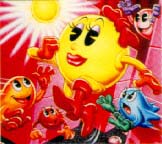 |
Ms. Pac Man (Midway,
1981): Found on almost every video game system, usually
via old-school game compilations such as "Greatest Arcade
Hits" by Midway. This Pac-Man sequel may not have had
the intellectual property following of the first—it
was hard not to see the Pac- Man Saturday cartoon, eat
the Pac-Man cereal or, worst, hear "Pac-Man Fever" on
the radio—but Ms. Pac-Man is, in every aspect, a
better game than the original.
As in almost all of the dozen Pac-Man games, the main
character is a large yellow dot with an ever-chomping
slice of a mouth—in fact, the designer was inspired
by seeing a pizza missing one slice. The Pac character
goes around a one-screen maze, eating smaller yellow dots
while being pursued by multi-colored ghosts. It is chased
by Inky, Blinky, Winky and Sue. They can't go through
walls like "regular" ghosts, but they can easily corner
our hero.
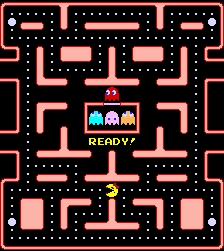 |
Visually, the only difference
between Pac-Man and Ms. Pac-Man is more color. The butter-yellow
in the original's labyrinths was replaced with fuchsia
and indigo, and the main character wasn't just a big,
yellow dot anymore: she had a bright red bow on her crown
to match her lipstick and a black dot for a beauty mole,
two years before Madonna but decades after Marilyn.
The real beauty of Ms. Pac Man is how it keeps the original's
simplicity while avoiding the boredom its predecessor
could create. Like the first, it is literally a game anyone
can pick up and play: move the joystick, avoid the ghosts,
eat all the dots, go to the next maze. Repeat. However,
the incentive is increased by smarter, more aggressive
ghosts, changing mazes and cutscenes showing how Pac-Man
and Ms. Pac-Man fell in love.
As one reviewer put it, Ms. Pac-Man is one of those games
that is still fresh if you pick it up every five days
or every five years. The great part is that it doesn't
matter. It's still fun.
 |
Geek trivia: Ms. Pac-Man
may have been the first video game to feature implied
sex. In one of the between-level animations, which shows
Pac-Man and Ms. Pac-Man falling in love, the power couple
are followed by a trail of Pac-Kids. This led to the inevitable
sequel called, of course, Baby Pac-Man.
For more info:
*Pac-Man History website: <http://www.classicgaming.com/pac-man/>
*Official website of Buckner & Garcia, "Pac-Man Fever"
singers
<http://www.bucknergarcia.com/>
*Read The Ultimate History of Video Games by Steven
Kent (Prima Publishing, ISBN: 0761536434)
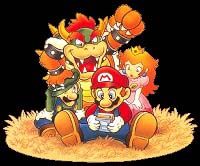 |
Super
Mario Bros. Series (Nintendo, 1985 - Present): Found
on all Nintendo home and handheld systems: Nintendo Entertainment
System (NES), Super NES, Nintendo 64, GameCube, GameBoy,
GameBoy Color, GameBoy Advance
According to a public survey, sometime in the early '90s
a chubby Italian plumber took the reign from Mickey Mouse
as the most recognized cartoon icon by American kids.
It was official—Mario beat Mickey the octogenarian.
Unlike Mickey, Mario wasn't remembered because he was
cute and had a high-pitched voice. What intrigued kids,
as well as adults, wasn't Mario himself but what he represented—adventure.
The series, started in 1985 with Super Mario Bros. and
continuing in 2002 with tentatively-titled Mario Sunshine,
is a perfect example of video game excellence. Each game
drops the player into a strange and unique world with
seemingly unlimited secrets. There are tangible rules,
however. Mario's conventional way of defeating enemies
is to jump on top of them, but some enemies have spikes
on their heads so the player is forced to find an alternative
method.
 |
Alternative methods and routes
are what the Mario games are all about. Do an Internet
search and you'll find tons of sites talking about "Mario
Negative Words," "Invisible Bonuses" and "Secret Underworld
Levels"—and, of note, the three mentioned items are
only referring to the very first Super Mario game. There
are more than a dozen Super Mario games and at least two
dozen spin-offs.
The original ancient cartridge,
sometimes packed with the light gun game Duck Hunt, can
be found at garage sales for around a buck. However, you
can feel confident playing any game in the Super Mario
series. Despite the improved animation and sound found
later in the series, the incredible depth of the game
has been there from the beginning.
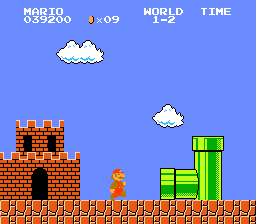 |
Geek trivia: Mario debuted
in 1981's Donkey Kong, the first major Nintendo game released
in America. In Donkey Kong, as a result of system limitations,
the plumber wears overalls because it was easier to show
his red arms on the contrasting color. The original Mario
also wears a cap because, in game creator Shigeru Miyamoto's
words, "I cannot come up with hairstyles so good." In
the newest game, coming in 2002 for the high-powered GameCube
system, Mario still wears a cap.
For more info:
*Mario's Mushroom Kingdom: <http://www.classicgaming.com/tmk/>
*Read Game Over: Nintendo's Battle To Dominate Video
Games by David Sheff
(GamePress, ISBN: 0966961706)
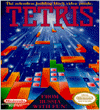 |
Tetris
(Various Publishers, 1987 - Present): On virtually any
system, including most graphic calculators and handheld
organizers.
The main characters in Tetris are variations of five different
shapes: a square, a T, an S and two Ls—one uppercase
(L) and one lowercase (l). They fall from heaven (though
some would argue they come from another extreme...) into
a well. The player places the pieces on the ground, twisting
them to his or her liking, trying to form a complete,
solid line from one side of the well to the other. A completed
line, once formed, is eliminated. More pieces then drop
from the sky at a faster pace. The above sequence repeats
until the well is full and the player fails. Otherwise,
the game doesn't stop. Ever.


|
Tetris, perhaps right after
the Tower of Hanoi, is the most addictive puzzle game
in history. It started in 1986 as a pet project of Russian
programmer Alexey Pajitnov, with the bricks represented
via text brackets. Evidently that was enough: from 1986
until—technically—now, dozens of major game
companies have fought over the Tetris property, including
Nintendo, Sega, Atari and Spectrum Holobyte. Luckily,
no one company was able to take complete ownership so
there are virtually no systems, computer or home, that
don't have a version of Tetris.
The real beauty of Tetris is its Zen-like simplicity.
It's so easy to be entranced: watching as the colorful
shapes fall, the well filling, brick by brick. You complete
lines to keep the well empty, which makes the bricks fall
faster. And as the bricks drop faster than you can say
your favorite explicative, going into a semi-hypnotic
trance suddenly becomes a requirement. There isn't any
time to think—only time for instinct.
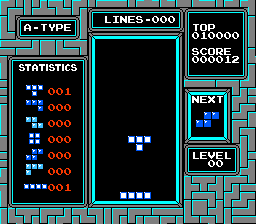 |
Like other addictive games
such as Ms. Pac-Man and Tony Hawk Pro Skater, Tetris is
a game that is simple to start and only gets as complicated
as you want it to be. Are you going to play cautious and
remove every line the moment you can? Or are you going
to push it and let the bricks pile up so you can score
multiple lines? It's totally up to you, which is what
video games are about.
Geek trivia: Tetris creator Alexey Pajitnov now works
for Microsoft.
For more info:
*The Tetris Taxonomy: <http://arkmay.com/tetris/>
*Tetris Lovers 2.0: <http://www.mindlick.com/tetris/>
*Read Game Over: Nintendo's Battle To Dominate Video
Games by David Sheff
(GamePress, ISBN: 0966961706)
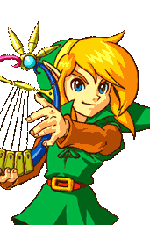 |
The
Legend of Zelda Series (Nintendo, 1987 - Present):
Found on all Nintendo home and handheld systems: Nintendo
Entertainment System (NES), Super NES, Nintendo 64, GameCube,
GameBoy, GameBoy Color, GameBoy Advance
Zelda is one of those games that never really ends. Sure,
you can "beat" it: navigate the labyrinths, fight the
final boss and save Princess Zelda. But what's in that
treasure chest on the other side of the village brook
you could never get across? Or behind the cave door, blocked
by the boulder you were too weak to move? See, you didn't
really beat it.
All the Zelda games follow the same basic premise. You
play Link, a cute Dungeons & Dragons-esque elf equipped
with a shield and sword. Link is out to save the village
princess Zelda from an uber-powerful evildoer and his
weaker cohorts. Link must defeat the mini-bosses first,
each dispatched in his own complex and sometimes hidden
labyrinth.
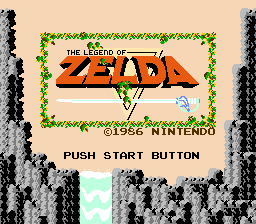 |
This is typical video game
stuff—Zelda doesn't have the most compelling storyline.
The beauty of the Zelda series is in the exploration.
Almost like a good mystery novel, Zelda requires the player
to stretch his or her brain to solve the puzzles. The
third Zelda, released in 1992, pitted Link against an
invisible enemy in a dim room. The only way to defeat
him was to use one of Link's bombs (found earlier in the
maze) to blow a hole in one of the walls, letting light
in and exposing the adversary. Many game designers have
attempted this type of thinking but fumble on the line
between easy puzzles and impossible challenges. Zelda
never disappoints—in the above example, observant
players would have noticed cracks in the back wall of
the enemy's layer. The answer was there all along.
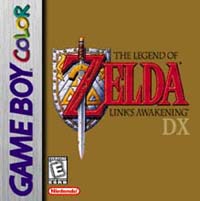 |
Zelda gives the player the
impression that when he or she fails, it is the player’s
own fault. This is a very simple video game principle
in theory and an equally difficult theory in practice,
but Zelda has it perfected. Every treasure chest can be
opened and every door can be entered, and this has compelled
millions of people to play through it just one last time.
Geek trivia: Zelda was the
first home system game to have a battery inside its cartridge
so players could save their game. Most games before Zelda
weren't large enough to necessitate saving one's place,
and the few games that were used a tedious letter-and-number
password system.
For more info:
*Zelda history site: <http://www.nintendoland.com/zelda/games/index.htm>
*Official Zelda Website: <http://www.zelda.com>
*Read Game Over: Nintendo's Battle To Dominate Video
Games by David Sheff
(GamePress, ISBN: 0966961706)
Tony
Hawk Pro Skater Series (Activision, 1999 - Present):
On Sony Playstation, Sony Playstation 2, Nintendo 64,
Nintendo GameCube, GameBoy Advance, Microsoft Xbox.
Sports games usually don't
translate well to video game form, particularly those
that emphasize complicated techniques. Tony Hawk Pro Skater—endorsed
by the popular sports figure—has succeeded because
it isn't trying to be a skateboard simulator but just
an addictive video game.
THPS, like most games on this list, does not make the
player have a specific, canned experience. The player
carves one’s own identity within the alternate universe,
going after goals only he or she wants to and getting
as serious or as superficial as desired. There are literally
months of play value in one THPS game, and each person
may have a unique and challenging experience.
 |
It starts simply enough:
the player selects one of the ten or so ragamuffin characters,
chooses an arena to ride in and just starts skating. The
rest is up to you. You can go after specific level goals,
which open new arenas and characters. You may opt to do
skateboard tricks off the objects in the arena, showboating
with complicated tricks to get a better score. Or you
can wander aimlessly around the huge arena, looking for
quirks and secrets, of which there are plenty.
Players can also try to outskate their friends, and beginning
with the recent XBox version, they can do it over the
net. Perhaps this will open the way for interactive online
gaming that has nothing to do with decapitating your friends,
a la violent shooters Epic Games' Unreal or id's Quake
series. THPS shows that games can be fun and competitive
without getting more gory than a scrapped knee.
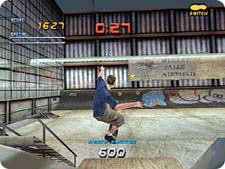 |
Geek trivia: Video games
and movie/sport licenses have had a horrible history,
the worst case being one of the first: E.T. The Extra
Terrestrial. Sources say that Atari, creators of the seminal
Atari 2600, paid more than $20 million for the E.T. license
and proceeded to make, by all accounts, a horrible game.
Part of the problem was that the programmer/game designer
was given five weeks, as opposed to five months, to create
a game in time for
the holiday season. Result? Atari took the returned cartridges,
estimated to be around five million, and buried them in
a New Mexico landfill for tax purposes. Some say, on a
quiet desert night, you can still hear E.T. calling...
For more info:
*Official Tony Hawk Pro Skater Video Game Website: <http://www.neversoft.com/TonyHawk/Welcome.html>
*Virtually any recent video
game magazine: at least four new versions of Tony Hawk
are planned for the 2001 - 2002 holiday season.
Still feel out of the loop? Check out this smattering
of links:
*Called "The New Yorker of video game sites," My Video
Games is one of the few sites to look at the medium in
a mature way. It may close soon because of financial difficulty,
so enjoy the wealth of articles while you can: <http://www.myvideogames.com>
*Games have been around for 25 years—you have a lot
of catching up to do! Start at Classic Gaming, which covers
the early days of gaming: <http://www.classicgaming.com>
*Aren't sure which old-school video game character fits
you best? Take this Myers-Briggs inspired psychological
test: <http://blog.ravenblack.net/quiz/videogame.pl>
|